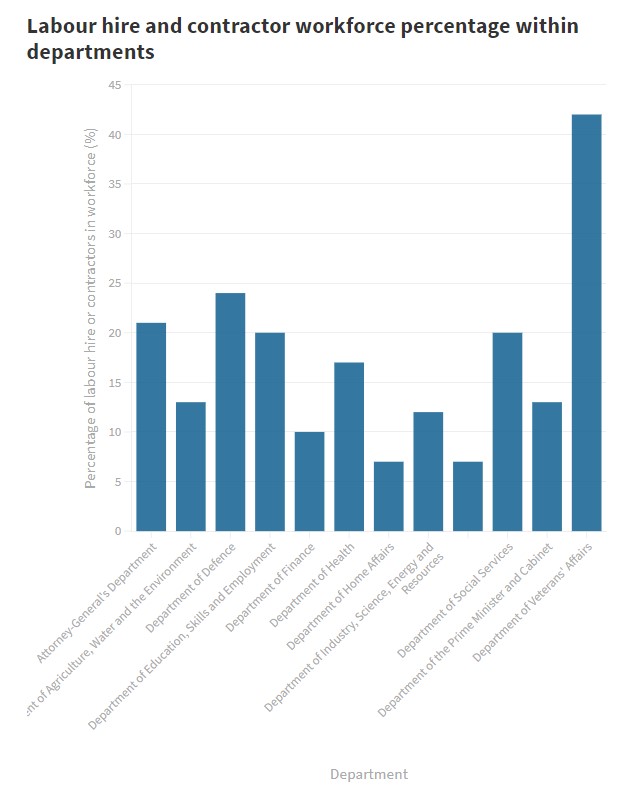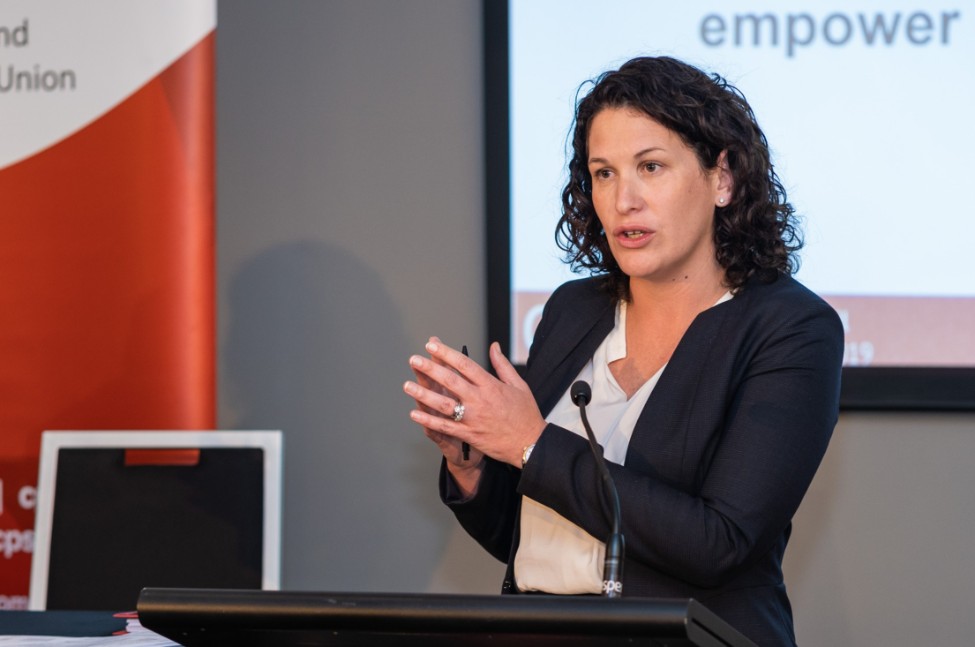
Nearly one in five people working in federal government departments are employed on external contracts or through labour-hire firms, analysis by The Canberra Times shows, amid concerns by critics the government was being privatised by stealth.
The latest workforce figures provided by the government’s key departments show a notable reliance on contracted or labour-hire employees to get around policies restricting the number of staff the public service can retain.
The Department of Veterans’ Affairs recorded the highest labour-hire or contracted workforce of 42 per cent when compared to the 17 per cent average across all departments who provided figures.
The department said its high percentage of non-APS staff reflected the fluctuation of its service delivery.
“It is imperative that our front-line services are always fully operational, for the health and well-being of the veteran community,” a department spokesperson said.
“Utilising a blended workforce, with the ability to call on contract or non-APS staff when needed is critical, and the department regularly makes adjustments to its workforce to ensure it delivers services as efficiently as possible and within its operating budget.”
While Veterans’ Affairs marked the high point for contracted workforces, Defence and the Attorney-General’s Department trailed behind with 24 and 21 per cent respectively.
On the other end of the scale, the Department of Infrastructure, Transport, Regional Development and Communications along with Home Affairs used the lowest percentage of contracted workers, both coming in at 7 per cent.

Despite repeated attempts, the Treasury and Foreign Affairs and Trade departments would not provide the figures upon request.
Overall, five of the 10 departments recorded having non-APS workforces totalling 20 per cent or more.
The Community and Public Sector Union’s national secretary Melissa Donnelly said the numbers are a reflection of a government policy, known as the Average Staffing Level, which imposes limits on APS staffing numbers to the level under the Howard government.
“Since 2013, we have seen over 12,000 jobs cut from the Commonwealth public sector because of the federal government’s decision to cut permanent jobs through an arbitrary staffing cap,” Ms Donnelly said.
“The [cap] has cut jobs but also driven outsourcing to labour hire companies and tax-evading multinationals in an effort to stealthily privatise the public sector. Since 2013, we have seen $3.2 billion given to big consulting companies to do work the APS can and should be doing.”
Finance Minister Simon Birmingham said the government was trying to strike the balance and that using both public service employees and labour hire employees strengthens the sector while saving money.
“During the COVID-19 pandemic the APS has played a critical role in keeping Australians safe and continues to deliver increased levels of government services to the community,” Mr Birmingham said in a statement.
“This has been achieved by having an agile and flexible workforce, where staff have moved between agencies to perform critical functions and external expertise has been utilised for defined periods, to address more time limited requirements.
“The government constantly adjusts the permanent staffing figures for every agency based on budget measures and whether any new pressures can best be met by reprioritising existing staff, or by engaging new staff.”
On the other side of the fence, Labor MP and public accounts and audit committee deputy chair Julian Hill said the policy was ultimately a waste of taxpayer money, which could be diverted to supporting a more permanent and capable public service workforce.
“The explosion of labour hire companies staffing government departments is a scandal and wastes vast sums of taxpayer money,” Mr Hill said.
“The very notion of permanent labour-hire workers in departments is ridiculous as it degrades capability and is profoundly unfair to those workers with no job security, who are often unable to even get a mortgage or have sick leave.
“The staffing caps should be abolished immediately to allow departments to save money by converting labour hire workers to staff, where that makes sense, and, at the very least, we need transparency in what’s going on.”
A similar sentiment was echoed in a landmark review on the public service conducted by former Telstra head David Thodey and delivered to the government in late 2019.
The government ultimately rejected the report’s recommendations to remove the staffing cap, stating it was “working effectively” and needed to deliver “budget repair”.
The union said it was crucial the public sector was adequately resourced in order to deliver the crucial services Australians rely upon.
“Investing in core public services should be an important nation-building exercise that contributes to our recovery,” Ms Donnelly said.
“For those hundreds of thousands of Australians directly affected by this crisis, the government’s failure to address public-sector capacity means that you will continue to face long call queues when calling Centrelink, more unanswered calls, and longer waits for those small businesses trying to access support from the ATO.”
Former finance minister Mathias Cormann was a strong supporter of using contracted work in the public service, and before the coronavirus pandemic took a sledgehammer to the government’s finances, had signalled the staffing cap could be reviewed when the budget was balanced.
With the former minister having since left government and the budget remaining years from surplus, the policy’s immediate future appears stable.
